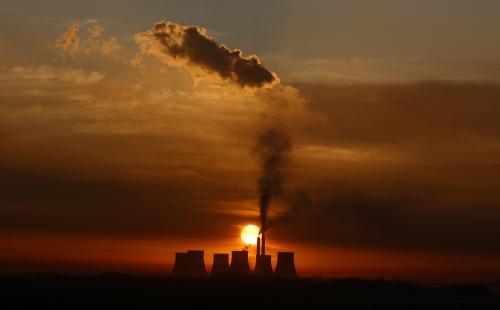EXECUTIVE SUMMARY
Heavy industry makes products that are central to our modern way of life but is also responsible for nearly 40% of global carbon dioxide (CO₂) emissions. Steel, cement, and chemicals are the top three emitting industries and are among the most difficult to decarbonize, owing to technical factors like the need for very high heat and process emissions of carbon dioxide, and economic factors including low profit margins, capital intensity, long asset life, and trade exposure.
Steelmaking uses coal both as a source of heat and as part of the chemical process of converting iron ore to elemental iron. Both of these uses produce carbon dioxide. Eliminating CO₂ emissions from steelmaking requires a change in process. Using hydrogen as the heat source and the chemical reducing agent can eliminate CO₂ emissions, or carbon capture can remove them. Steel can also be recycled without CO₂ emissions, but demand for steel is too large to be met with recycled steel alone.
Cement production also releases CO₂ as part of the chemical process, in this case when limestone is heated to very high temperature to produce calcium oxide “clinker,” the cement’s primary component. Other substances can be mixed with clinker while still maintaining cement quality, but the primary method of decarbonizing the sector is to capture the CO₂ and store or find a use for it.
The chemical industry is different from the other two, encompassing many thousands of processes and products. However, more than 90% of “organic,” or carbon-containing, chemicals are derived from just a few building blocks, which are produced in large quantities and traded internationally. The chemical industry is also unique in that it uses coal, oil, and natural gas as feedstocks that are transformed into final products, not just sources of energy. Fossil fuels will likely still be feedstocks in a zero-carbon world, with process electrification and zero-carbon hydrogen as methods of removing CO₂ emissions. Ammonia is crucial for fertilizer and although it does not contain carbon, hydrogen needed for its production is today made from natural gas, with carbon dioxide as a by-product.
These industries and others share technical challenges in common, including process emissions of carbon dioxide, the need for high heat, and use or potential use of hydrogen. A number of technical solutions can be shared across the sectors as well, which are interrelated and synergistic in some cases. Carbon dioxide capture and utilization or storage (CCUS) is an option for emissions that cannot be eliminated or where elimination is prohibitively expensive.
Despite their emissions and energy intensity, the steel, cement, and chemical industries are with us to stay. Much of the infrastructure needed to build a low-carbon economy will be made of steel and cement. Reductions in single-use plastics could help reduce organic chemical demand, but plastics have useful qualities that are hard to replace, such as their light weight and durability. Policy will be crucial to achieving industrial decarbonization, since it will require large capital investments in low-margin industries, not something that most companies will be able to do on their own. Governments can assist with the investment cost, provide demand pull for low-carbon products, and use trade policy to protect domestic low-carbon industries from cheaper but higher-carbon products from abroad. These policies use different levers to spur action, and industry may need all of them to make such extensive changes.
-
Acknowledgements and disclosures
Jenn Perron provided research support, Ted Reinert and Caroline Klaff edited this paper, and Rachel Slattery provided layout.










